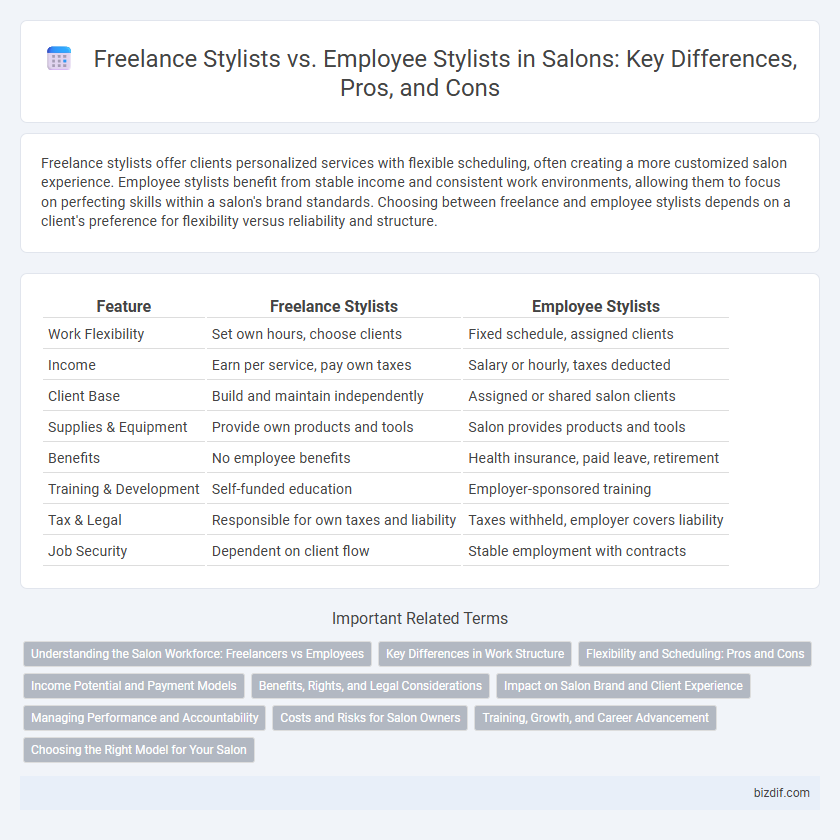Freelance stylists offer clients personalized services with flexible scheduling, often creating a more customized salon experience. Employee stylists benefit from stable income and consistent work environments, allowing them to focus on perfecting skills within a salon's brand standards. Choosing between freelance and employee stylists depends on a client's preference for flexibility versus reliability and structure.
Table of Comparison
| Feature | Freelance Stylists | Employee Stylists |
|---|---|---|
| Work Flexibility | Set own hours, choose clients | Fixed schedule, assigned clients |
| Income | Earn per service, pay own taxes | Salary or hourly, taxes deducted |
| Client Base | Build and maintain independently | Assigned or shared salon clients |
| Supplies & Equipment | Provide own products and tools | Salon provides products and tools |
| Benefits | No employee benefits | Health insurance, paid leave, retirement |
| Training & Development | Self-funded education | Employer-sponsored training |
| Tax & Legal | Responsible for own taxes and liability | Taxes withheld, employer covers liability |
| Job Security | Dependent on client flow | Stable employment with contracts |
Understanding the Salon Workforce: Freelancers vs Employees
Freelance stylists offer salons flexibility and diverse skill sets, often attracting clients seeking personalized services, whereas employee stylists provide consistency and loyalty, contributing to stable salon operations and brand identity. Understanding the differences in compensation structures, scheduling, and client management helps salons optimize workforce efficiency and meet business goals. Balancing freelancers and employees strategically can enhance service variety while maintaining quality and customer retention.
Key Differences in Work Structure
Freelance stylists operate independently, managing their own schedules, clients, and business expenses, while employee stylists work under a salon's supervision with fixed hours and a steady paycheck. Freelancers have the flexibility to set their rates and work locations, whereas employee stylists benefit from salon-provided tools, product inventory, and marketing support. These structural differences influence income stability, autonomy, and professional growth opportunities within the hairstyling industry.
Flexibility and Scheduling: Pros and Cons
Freelance stylists enjoy significant flexibility, setting their own hours and choosing clients, which appeals to those seeking work-life balance. Employee stylists have a structured schedule with consistent hours, providing steady income but less control over shifts and time off. Clients may find freelance scheduling more convenient, yet employee stylists often offer more reliable availability during salon peak times.
Income Potential and Payment Models
Freelance stylists typically earn income based on a commission or percentage of their services, allowing higher earning potential through client volume and pricing flexibility, while employee stylists receive a fixed hourly wage or salary with benefits but limited scalability. Payment models for freelance stylists vary from hourly rates to chair rental or commission splits, enabling greater control over earnings, whereas employee stylists operate under consistent pay but less financial autonomy. Understanding these differences is crucial for stylists seeking to optimize income based on their career priorities and market demand.
Benefits, Rights, and Legal Considerations
Freelance stylists enjoy greater flexibility and control over their schedules but lack access to employee benefits such as health insurance, paid leave, and unemployment protection. Employee stylists receive legally mandated protections including minimum wage, workers' compensation, and employer-provided benefits, which contribute to job security and financial stability. Legal considerations require salons to correctly classify stylists to avoid misclassification penalties, ensuring compliance with labor laws and protecting both parties' rights.
Impact on Salon Brand and Client Experience
Freelance stylists offer salons flexibility and access to diverse talents, enhancing the brand with a variety of unique styles but may create inconsistent client experiences due to varying service standards. Employee stylists contribute to a cohesive salon identity and reliable client satisfaction through standardized training and brand alignment. Balancing freelance creativity with employee consistency is essential for maintaining a strong salon reputation and loyal clientele.
Managing Performance and Accountability
Freelance stylists manage their own schedules and client relationships, requiring clear agreements to ensure accountability for service quality and punctuality. Employee stylists operate under salon management, which provides structured performance evaluations and consistent oversight to maintain salon standards. Effective performance management in both models depends on transparent communication and measurable goals aligned with customer satisfaction and salon reputation.
Costs and Risks for Salon Owners
Freelance stylists reduce fixed labor costs for salon owners by charging per service or on commission, minimizing payroll expenses and benefits liabilities. Employee stylists require salaries, benefits, and workers' compensation, increasing overhead and exposing salons to risks like unemployment claims and legal compliance. Balancing cost control with consistent service quality is essential for salon owners managing stylist workforce models.
Training, Growth, and Career Advancement
Freelance stylists often benefit from flexible, self-directed training opportunities that allow them to tailor their skill development to niche markets or personal interests, fostering rapid growth in specialized techniques. Employee stylists typically have access to structured training programs, mentorship, and career advancement pathways within established salon hierarchies, which can lead to more consistent professional development and potential management roles. Both paths offer unique advantages, with freelancers prioritizing autonomy and innovation, while employees gain stability and systematic growth prospects.
Choosing the Right Model for Your Salon
Freelance Stylists offer flexibility and reduced overhead costs by working on a commission basis, ideal for salons aiming to scale without a heavy payroll. Employee Stylists provide consistency, brand loyalty, and control over service standards, making them suitable for salons prioritizing client retention and team cohesion. Evaluating your salon's financial goals, client base stability, and management capacity is crucial to choosing the right stylist model for sustainable growth.
Freelance Stylists vs Employee Stylists Infographic

 bizdif.com
bizdif.com